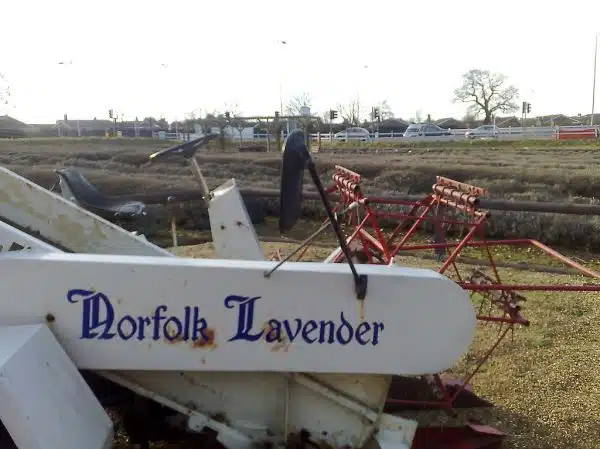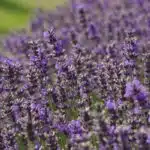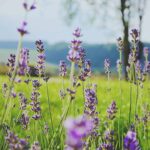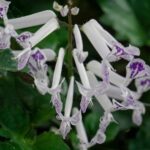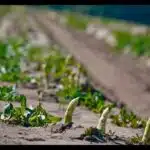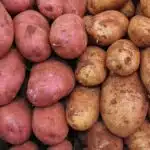Lavender is a perennial herb that has been widely cultivated for its fragrant flowers and essential oils. The plant is native to the Mediterranean region, but it is now grown in many parts of the world. Harvesting lavender requires knowledge and skill, as the timing and technique can greatly affect the quality and quantity of the yield.
As a lavender harvesting expert, I have spent years studying and practicing the art of harvesting this versatile herb. In this article, I will share my insights on how to harvest lavender correctly to maximize its potential. Whether you are a farmer looking to grow lavender commercially or a home gardener seeking to enjoy its aesthetic and aromatic benefits, this guide will provide you with practical tips and strategies for successful lavender harvesting.
Understanding Lavender Cultivation
Lavender is a perennial plant that belongs to the mint family. It is known for its fragrant aroma and beautiful purple flowers, making it a popular choice in gardens and as an essential oil. Lavender propagation can be done through seeds or cuttings, but cuttings are the most common method due to their higher success rate. Once established, lavender requires minimal maintenance and can thrive in various soil types.
Pest management is crucial in lavender cultivation as pests such as aphids and spider mites can damage the plants’ leaves and stunts their growth. Insecticidal soap, neem oil, or horticultural oil can be used to control pests. Additionally, proper irrigation practices must be observed to avoid root rot and fungal infections.
Lavender cultivation requires patience and attention to detail. With proper care and pest management practices, lavender plants can grow healthy and produce an abundance of flowers for harvesting. Identifying the right time to harvest is crucial for maximum yield and quality of essential oils.
Identifying The Right Time To Harvest
Ah, the sweet scent of lavender. It’s like a breath of fresh air for those who seek relaxation and calmness. But when is the best time to harvest it? As a lavender harvesting expert, I would say that timing is everything in this process. Knowing when to harvest your lavender plants is crucial for obtaining optimal results.
To determine if your lavender plant is ready for harvesting, you must consider several factors. First, look at the color of the flowers. The buds should be plump and vibrant in color, ranging from pale blue to deep purple. Second, check if the flowers have opened up or begun to wilt. Lastly, give them a gentle squeeze; if they feel firm and spring back into place after releasing them, then they are ready for harvesting.
When it comes to best harvesting practices, it’s essential to wait until the optimal harvesting conditions are met before starting the process. One critical factor is weather conditions; you want to avoid harvesting during rainy or humid days as these can cause mold growth on your harvested plants. Additionally, make sure that you’re not cutting too low on the stem as this can damage future growth potential for your plant.
- Here are five tips on identifying when your lavender plant is ready for harvesting:
- Check the color of the flowers.
- Observe if they have opened up or started wilting.
- Give them a gentle squeeze.
- Avoid harvesting during rainy or humid days.
- Don’t cut too low on the stem.
Now that you know how to identify when your lavender plants are ready for harvesting let’s move on to preparing for this next step in our journey towards beautiful fragrant oils and dried flower arrangements.
Preparing For Harvesting
- Lavender is best harvested when the buds are just beginning to open, and when the flower stems are firm and sturdy.
- In order to maximize the yield, the soil should be conditioned a few weeks before harvesting, using compost and mulch.
- It is important to check that the soil is not too wet or too dry, as this can affect the quality of the lavender.
- Picking the lavender at the right time is essential for ensuring that the oils are at their peak of concentration.
- To protect against illness and injury, it is important to wear protective gear such as gloves and long sleeves.
- Additionally, wearing a hat, long pants, and closed-toed shoes is recommended when harvesting lavender.
Identifying Maturity
Identifying Maturity is an essential aspect of preparing for harvesting lavender. Assessing maturity is a crucial step in ensuring that the flowers are at their peak, and the plant’s yields are optimized. To identify maturity, one must observe the color of the buds, as well as the number of open flowers on the plant. The buds should have a vibrant purple hue, while the flowers should be abundant and fragrant.
Harvesting timing is also critical when preparing for lavender harvest. Timing is dependent on several factors, including weather conditions and plant variety. Typically, lavender harvest begins in mid to late June and can continue through early August. It’s best to time harvesting during dry weather conditions when there is no risk of rain or moisture damage to the flowers. Additionally, harvesting should occur during cooler temperatures as it will help preserve the fragrance of the flowers.
Once maturity has been identified, it’s time to begin harvesting. Harvesting should be done using sharp scissors or pruning shears to avoid damaging the plant. It’s essential to cut only about one-third of each stem, leaving enough foliage for healthy regrowth in subsequent years. Flowers should be placed in a basket or container immediately after cutting and stored in a cool, shaded area until they can be further processed or dried for later use. By following these guidelines on assessing maturity and timing harvesting correctly, you can ensure that your lavender yields are optimal and your plants remain healthy year after year without fail!
Conditioning The Soil
Soil preparation is a crucial aspect of preparing for lavender harvesting. To ensure that the plants are healthy and productive, the soil must be properly conditioned to meet their nutrient requirements. Before planting, it’s recommended to perform a soil test to determine the pH level and nutrient deficiencies. Lavender thrives in well-draining soil with a pH level between 6.5 and 7.5. If the pH level is too low or high, it can lead to stunted growth and decreased yields.
To condition the soil for lavender cultivation, it’s essential to add organic matter such as compost or well-rotted manure. This helps improve soil structure, water-holding capacity, and nutrient availability. Incorporating a balanced fertilizer with low nitrogen content can also provide essential nutrients needed for optimal growth without promoting excessive foliage growth at the expense of flower production. Additionally, mulching around the base of each plant can help retain moisture in the soil and prevent weed growth while also improving overall soil health.
In conclusion, conditioning the soil is an integral part of preparing for lavender harvesting. Proper soil preparation ensures that plants have access to essential nutrients needed for healthy growth and maximum yields. By performing a soil test, adding organic matter, using balanced fertilizers with low nitrogen content, and mulching around plant bases, you can ensure that your lavender plants thrive year after year!
Wearing Protective Gear
As a lavender harvesting expert, I would like to emphasize the importance of wearing protective gear during the harvesting process. Wearing the appropriate gear not only protects you from potential injuries but also prevents harmful substances from coming into contact with your skin. The benefits of wearing protective gear go beyond personal safety as it helps maintain the quality and purity of harvested lavender.
To ensure proper protection, it is recommended to wear long-sleeved shirts and pants made of lightweight, breathable fabric to shield yourself from direct sunlight while allowing proper ventilation. Additionally, gloves are essential for preventing cuts, scratches, and irritation caused by handling dried lavender stems. A pair of sturdy boots or closed-toe shoes with good traction should also be worn to prevent slips and falls on uneven terrain.
In conclusion, wearing protective gear during lavender harvesting is crucial for both personal safety and ensuring high-quality harvests. Long-sleeved shirts and pants made of lightweight fabrics, gloves, and sturdy footwear are highly recommended when working in the field. By taking these steps to protect yourself, you can confidently focus on producing premium-grade lavender that will benefit others who use it for various purposes.
Choosing The Right Tools
After preparing for harvesting, the next step is to select appropriate tools. Choosing the right harvesting tools can ensure that you harvest your lavender efficiently and without damaging the plants. The ideal equipment for harvesting lavender includes gloves, pruning shears or scissors, a basket or bucket, and a tarp.
When selecting pruning shears or scissors, look for those with sharp blades to avoid crushing the stems. A basket or bucket should be large enough to hold a good amount of lavender, but not too big that it becomes too heavy to carry. It’s also important to use a tarp to collect any fallen flowers during harvesting. This will prevent waste and keep your work area clean.
Maintaining your harvesting equipment is crucial in ensuring its longevity and effectiveness. After each use, clean your tools thoroughly with warm soapy water and dry them completely before storing them in a dry place. Regularly sharpen your pruning shears or scissors as dull blades can damage the plant and make harvesting more difficult. By choosing appropriate tools and maintaining them well, you can ensure successful lavender harvests year after year.
Transition:
Now that we have discussed selecting appropriate tools and maintaining equipment let’s move on to discussing different techniques for harvesting various varieties of lavender.
Harvesting Techniques For Different Varieties
Harvesting lavender is an important step in the cultivation process. Different lavender varieties require different harvesting techniques, which can affect the quality and quantity of the yield. As a lavender harvesting expert, it is crucial to understand these techniques to ensure that your crop is harvested at the right time and in the correct manner.
To harvest English lavender, for example, you need to wait until the flowers have fully opened and are at their peak fragrance. This typically occurs in mid-summer. The best way to harvest English lavender is by cutting off entire stems with a sharp sickle or knife. On the other hand, French lavender has a shorter harvesting period as its flowers bloom earlier in summer. For this variety, it’s best to harvest only the flower spikes when they are just starting to open.
Harvesting lavender can be a therapeutic and enjoyable experience. It’s satisfying to see how much you’ve accomplished after a long day spent working in a field of fragrant plants. To make your harvest an even more fulfilling experience, try incorporating these bullet points into your routine:
- Take breaks often.
- Stay hydrated throughout the day.
- Wear protective gear such as gloves and long-sleeved shirts.
- Listen to calming music while you work.
- Take time to appreciate your surroundings.
Knowing how to harvest different varieties of lavender using proper techniques can help ensure that you get the most out of your crop. In our next section, we’ll discuss hand harvesting vs. machine harvesting and how each method can impact your yield and overall profitability.
Hand Harvesting Vs. Machine Harvesting
Harvesting lavender is a crucial process in its cultivation. The method used to harvest the plant depends on the type of lavender, quantity, and quality required for use. Hand harvesting and machine harvesting are two primary methods used by farmers to harvest lavender.
Hand harvesting is a traditional method that involves cutting the stems manually using pruning shears or sickles. This method is time-consuming but has its advantages. Hand harvesting allows for greater care when selecting which buds to harvest and can lead to higher-quality essential oils. Additionally, hand harvesting is more efficient for small batches of lavender as it does not require significant investments in machinery.
Machine harvesting is a modern technique that uses specialized equipment designed for large-scale operations. The machines are equipped with vibrating heads that comb through the plants and strip them of their flowers. While machine efficiency can save time significantly, it requires a considerable investment in equipment and infrastructure. Additionally, machine harvesting may result in lower quality essential oils due to less accuracy when selecting only mature buds.
The cost comparison between hand harvesting and machine harvesting depends on the size of the farm, labor requirements, and expected output. While machine efficiency leads to increased productivity and decreased labor requirements, it requires significant initial capital investment in machinery maintenance costs over time. In contrast, hand harvesting is labor-intensive but may be more manageable financially for smaller farms with lower production needs. Farmers must consider these factors when deciding which method to use for their lavender crops.
As lavender production continues to grow worldwide, post-harvest processing becomes increasingly important in ensuring high-quality products from start to finish. Post-harvest processing includes drying techniques, oil extraction methods, and packaging procedures that all contribute to the final product’s overall quality. Understanding post-harvest processing techniques enables farmers to produce premium lavender products that meet consumer demand while also maximizing profits.
Post-Harvesting Processing
After harvesting lavender, the post-harvesting process is crucial to maximize the quality and value of the crop. The first step is to sort out the harvested flowers, removing any damaged or discolored ones. Then, it is essential to wash the flowers carefully to remove dirt and dust. However, excessive washing should be avoided as it can damage the flowers and reduce their aroma.
Once the lavender flowers are clean, they can be used for various purposes such as making essential oils or dried flower arrangements. To make essential oil, steam distillation is commonly used. Dried lavender flowers are perfect for making sachets, potpourri, or even culinary uses in teas and desserts. For those intending to sell their lavender products, it’s important to ensure that they are packaged appropriately and labeled correctly with useful information such as product ingredients and expiration dates.
When selling harvested lavender products, there are several tips that can help increase sales. Firstly, focus on creating high-quality products that stand out from competitors by using unique packaging or adding special touches like personalized labels or gift wrapping. Secondly, consider offering a variety of products at different price points to cater to different customers’ budgets. Finally, take advantage of online marketplaces and social media platforms to reach a wider audience.
To prepare dried lavender flowers for use in various products mentioned above requires careful drying techniques. As we move into this next step of post-harvest processing; we will explore how best you can dry your harvested lavender flowers efficiently without damaging them.
Drying Lavender Flowers
After the lavender has been harvested, it is important to proceed with post-harvesting processing. During this phase, the flowers are sorted, cleaned and bundled into manageable sizes. The process of sorting involves separating the stems from the flowers to ensure that only the flowers are used. Cleaning is done to remove any dirt or debris that may have been picked up during harvesting.
Different drying methods can be employed to dry lavender after it has been processed. One method is air-drying, which involves hanging the bundles of lavender upside down in a well-ventilated area away from direct sunlight. Another method is using a dehydrator, which allows for faster and more controlled drying of the flowers. Lastly, oven-drying can also be used but it requires low heat and constant monitoring to avoid burning the flowers.
Uses for dried lavender include making sachets for closets and drawers, adding fragrance to homemade soaps and candles or using it as an ingredient in cooking such as lavender shortbread cookies or infused honey. It can also be used in aromatherapy as its scent helps promote relaxation and calmness.
It is crucial to store lavender properly after it has been dried. This ensures that its potency remains intact. Store dried lavender in an airtight container away from direct sunlight and moisture. When stored properly, dried lavender can last up to two years without losing its aroma or flavor.
Storing Lavender Properly
To ensure the longevity of your lavender, it is important to store it properly. The optimal conditions for storing lavender include a cool, dry place with good air circulation. Direct sunlight should be avoided as it will cause the essential oils in the plant to degrade. When dried appropriately and stored correctly, lavender can last up to two years.
Choosing the right container for storing your lavender is also crucial. Airtight containers such as glass jars or metal tins are ideal for preserving the fragrance and quality of your lavender. Avoid plastic containers as they may contain chemicals that could affect the scent or even damage the plant material over time. It is also recommended to label your container with the date of harvest and type of lavender for future reference.
Storing your freshly harvested lavender correctly will not only extend its shelf life but also maintain its aroma and flavor. By following these guidelines, you can enjoy the benefits of your hard work long after harvesting season has passed.
To further maximize yield from your lavender plants, pruning plays an essential role. Proper pruning techniques promote healthy growth and increase flower production by removing dead or diseased stems and promoting new growth from lower on the plant. In addition to increasing yield, regular pruning helps maintain a pleasing shape for aesthetic appeal in a garden setting.
Maximizing Yield Through Pruning
Pruning is an important part of lavender harvesting that requires knowledge of the appropriate pruning techniques to optimize yield. Proper timing of pruning is essential to ensure maximum quality and quantity of lavender production. Pruning during the summer months is recommended to reduce the risk of winter damage while also increasing the number of flowering stems in the plant. Pruning should be done at the end of the flowering cycle to ensure that the new stems are not cut off during the pruning process. Pruning at this time also encourages lateral growth and the production of more flowering stems. To ensure the best yield, pruning should be done on a regular schedule of every four to six weeks. Through proper pruning techniques and an effective pruning schedule, yields can be maximized and quality of lavender production improved.
Pruning Techniques
As a lavender harvesting expert, I know that the key to maximizing yield is through proper pruning techniques. Pruning frequency is crucial in ensuring that the lavender plants produce robust and healthy blooms. In general, it is best to prune lavender once a year, usually in late summer or early fall after the blooming season has ended.
Different growth patterns require specific pruning techniques to achieve maximum yield. For instance, for compact varieties of lavender, such as Munstead or Hidcote, it is essential to prune them back by about one-third of their current size. This technique helps promote bushier growth and more significant flower production in the following season. On the other hand, for larger varieties such as Grosso or Provence, pruning should be done more aggressively, cutting back up to half of the plant’s current size.
In conclusion, by understanding pruning frequency and utilizing appropriate pruning techniques for different growth patterns, you can maximize your lavender yield significantly. Whether you are growing lavender commercially or for personal use, investing time into proper pruning practices will pay off in the form of abundant blooms and a healthier overall plant.
Yield Optimization
As a lavender harvesting expert, I know that maximizing yield is not only about proper pruning techniques. It also involves yield optimization, which encompasses various field management techniques and the use of appropriate harvesting equipment. Yield optimization aims to achieve the highest possible yield while maintaining the quality of the lavender crop.
To optimize yield, it is essential to select the right time for harvesting. The optimal time for harvesting lavender is when half of the flowers on a given stem have bloomed. At this stage, the flowers contain high levels of essential oils, making them ideal for producing high-quality products such as essential oils and dried flower arrangements. Additionally, using appropriate harvesting equipment such as sickles or shears helps prevent damage to the plants and allows for faster and more efficient harvesting.
Another important aspect of yield optimization is field management. This includes soil preparation, irrigation management, and pest control. Lavender requires well-draining soil with a pH range between 6.5-8.0 and moderate water levels to thrive. Proper pest control measures such as scouting for pests regularly and applying appropriate treatments would ensure that pests do not affect plant growth or reduce yields significantly. By implementing these field management techniques alongside proper pruning practices and using appropriate harvesting equipment, one can maximize their lavender yield significantly.
Pruning Schedule
As a lavender harvesting expert, I understand the importance of pruning in maximizing yield. Pruning is an essential aspect of lavender cultivation as it helps promote plant health and increase flower production. The benefits of pruning include increased airflow, sunlight penetration, and the removal of dead or diseased branches. These factors contribute to higher yields and improved quality of the lavender crop.
Pruning techniques for bushy lavender differ from those used for other varieties. Bushy lavender requires frequent pruning to maintain its shape and encourage new growth. The best time to prune bushy lavender is in early spring or late winter before new growth appears. Pruning should be done using sharp shears to avoid damaging the plant’s stems.
Creating a pruning schedule is crucial for maximizing yield through proper pruning techniques. A regular pruning schedule ensures that plants remain healthy and produce high-quality flowers throughout their lifespan. By incorporating these techniques into their lavender cultivation practices, farmers can significantly increase their yields and provide top-quality products for their customers.
Harvesting Lavender For Essential Oils
As the saying goes, “prune in haste, harvest at leisure.” One of the most crucial aspects of maximizing lavender yield is proper pruning. However, once the pruning is done, it’s time to move on to harvesting lavender for its essential oils. Harvesting at the right time ensures that you get high-quality oil and also helps prevent plant diseases.
The first step in harvesting lavender for essential oils is knowing when to do so. Lavender plants must be harvested during their peak blooming season, which usually occurs in mid-summer. At this stage, the flowers contain the maximum amount of oil and will provide a higher yield during the distilling process.
The next step is to use oil extraction techniques that are tailored to your needs. There are different methods of extracting oil from lavender flowers, including steam distillation, solvent extraction, and CO2 extraction. While each method has its advantages and disadvantages, steam distillation remains the most commonly used technique for extracting lavender essential oil due to its efficiency and low cost.
Nested bullet point list:
Factors such as climate, growing conditions, and plant variety can affect harvest time
Researching optimal harvest times based on location can help maximize yield
Some varieties may have longer or shorter blooming periods than others
Steam distillation involves heating lavender flowers with water to release their essential oils
The resulting steam is then condensed into liquid form for collection
This method requires specialized equipment but yields high-quality oil
Solvent extraction involves using a chemical solvent like hexane to extract essential oils from plant material
This method is more expensive and less environmentally friendly than steam distillation
However, it can produce a higher volume of oil in a shorter amount of time
In conclusion, proper pruning sets the stage for successful lavender harvesting. By timing your harvest correctly and utilizing appropriate oil extraction techniques like steam distillation or solvent extraction, you can ensure a high-quality yield of essential oil. In the next section, we will explore tips for harvesting lavender in different climates to help you get the most out of your harvest.
Tips For Harvesting Lavender In Different Climates
Harvesting lavender requires careful consideration of the climate in which it is grown. Different climates can greatly affect the quality and yield of lavender, making it important to understand how to harvest in various conditions. Moisture considerations are one of the most important factors to keep in mind when harvesting lavender. While lavender is known for its ability to thrive in dry conditions, too much moisture can lead to rotting and mold growth. Therefore, it is essential to harvest lavender when the plants are dry and avoid harvesting during or immediately after rainfall.
Dealing with extreme temperatures is another crucial factor that must be taken into account when harvesting lavender. In hot climates, lavender may mature faster than usual, while in cooler regions, it may take longer to reach maturity. Harvesting should be done before the flowers become fully matured or before the heat of the day sets in. Additionally, if temperatures rise above 100°F (38°C), it is best to wait until they cool down before continuing with harvesting.
Here is a table summarizing some tips for harvesting lavender in different climates:
| Climate | Moisture Considerations | Extreme Temperature Tips |
|---|---|---|
| Dry Climates | Harvest when plants are dry; avoid harvesting after rainfall | Harvest early morning or late afternoon |
| Humid Climates | Wait until mid-morning or early afternoon; use a dehumidifier if possible | Harvest on cloudy days |
| Hot Climates | Harvest before heat of day sets in; avoid high-temperature periods | Water plants regularly and ensure good soil drainage |
| Cool Climates | Harvest later than usual; protect from frost damage | Cover plants overnight during frost warnings |
In conclusion, understanding how different climates affect lavender growth is essential to successful harvesting. By considering moisture levels and dealing with extreme temperatures appropriately, you can ensure that your lavender crop remains healthy and productive. However, even with proper care, issues may arise during the harvesting process. The subsequent section will provide troubleshooting tips for common lavender harvesting problems.
Troubleshooting Common Lavender Harvesting Problems
Preventing contamination is key to extending lavender’s shelf life. Remember to only harvest when the plant is dry, preferably in the morning after the dew has dried off. Use clean pruning shears that have been disinfected with alcohol to avoid introducing any diseases or bacteria into the plant. Make sure all containers and drying racks have also been thoroughly cleaned and sanitized.
Once harvested, it is essential to dry lavender properly for it to retain its scent and flavor. Spread out the stems in a single layer on a drying rack or hang them upside down in a warm, dry, and well-ventilated area out of direct sunlight. Avoid stacking stems as this can cause them to mold or rot, ruining the entire batch. Drying can take anywhere from a few days up to two weeks depending on environmental conditions.
To extend lavender’s shelf life even further, store it properly once dried. Keep it in an airtight container away from heat and light sources like windowsills and stoves. Lavender can also be stored in the freezer for up to six months without losing its fragrance or flavor. Proper harvesting techniques coupled with correct drying and storage methods will help you get the most out of your lavender crop for both culinary and decorative purposes.
Transitioning into harvesting lavender for culinary purposes, there are several things you need to keep in mind before using your freshly harvested flowers for cooking or baking purposes.
Harvesting Lavender For Culinary Purposes
Harvesting lavender for culinary purposes is a task that can bring immense satisfaction and joy. The process of harvesting the fragrant flowers is not only therapeutic but also rewarding, as you get to use the harvest in various recipes. Lavender has a subtle floral flavor that adds depth to desserts, making them more interesting and memorable.
To harvest lavender for culinary purposes, you need to make sure that the plant has reached its peak bloom. This means that the flowers should be fully open and have not yet started to wilt. Gently pick the flower stalks from the plant, making sure not to damage the stems or leaves. Once you have harvested enough flowers, rinse them gently under cold water to remove any debris or insects.
Using lavender in desserts is a wonderful way to add an unexpected twist to your favorite recipes. Here are some ideas on how to incorporate lavender into your culinary creations:
- Sprinkle dried lavender over vanilla ice cream
- Infuse cream with fresh lavender for panna cotta or custards
- Use lavender sugar in baked goods like cookies or cakes
Another great way to enjoy your fresh lavender harvest is by creating DIY tea blends. Lavender tea has a soothing effect that can help you relax after a long day. Simply steep fresh or dried lavender flowers in hot water for several minutes and enjoy!
Now that you know how to harvest lavender for culinary purposes, it’s time to start thinking about marketing and selling your harvest. But before we delve into that topic, let’s first explore some creative ways of using your freshly harvested blooms!
Marketing And Selling Your Lavender Harvest
Now that you have successfully harvested your lavender crop, it’s time to turn it into a product. There are a variety of ways in which you can use lavender, and the possibilities are endless. You can make sachets, soaps, candles, essential oils, or even culinary products like lavender-infused honey or tea.
When it comes to marketing your lavender products, it’s important to identify your target audience. Depending on the type of product you’ve created, your target audience may vary. For example, if you’ve made lavender essential oil or sachets, your target audience could be people who enjoy aromatherapy or want to use natural remedies for relaxation. On the other hand, if you’re selling culinary products like honey or tea, foodies and health-conscious individuals could be your target market.
To effectively market your lavender products to your target audience, consider using social media platforms such as Instagram or Facebook. Creating visually appealing content showcasing your products will attract potential customers and drive sales. Additionally, attending farmers’ markets or local craft fairs can also expose your products to a wider audience and provide an opportunity for face-to-face interactions with potential customers.
With careful planning and execution of marketing strategies tailored towards specific audiences, you can successfully sell your lavender products and establish a loyal customer base. Remember to stay creative with product ideas and engage with customers through various channels for better success.
Conclusion
Lavender harvesting is an art that requires knowledge, patience, and dedication. As a lavender harvesting expert, I have learned the intricacies of this delicate process through years of experience and research. Understanding the cultivation of lavender is crucial in identifying the right time to harvest. Preparing for harvesting involves choosing the right tools and techniques for different varieties.
Harvesting lavender can be a therapeutic and rewarding experience if done correctly. It requires attention to detail, careful planning, and an appreciation for nature’s bounty. Troubleshooting common harvesting problems is an essential skill that every lavender farmer should possess. Whether you are harvesting for culinary purposes or marketing your harvest, it is crucial to understand the various techniques involved in this process.
So go ahead and immerse yourself in the beauty of lavender farming. Embrace this art form with open arms, let it lead you on a journey of self-discovery, and allow its soothing fragrance to intoxicate your senses. Remember that each harvest is unique, just like each individual plant that grows from it. So take pride in your work as a lavender farmer, and let your passion guide you towards success!
Image Credits
- “Lavender Harvester” by markhillary (featured)

